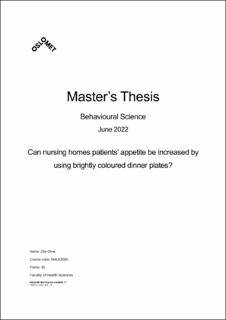Can nursing homes patients’ appetite be increased by using brightly coloured dinner plates?
| dc.contributor.advisor | Krogsvold, Linda Mari | |
| dc.contributor.advisor | Ree, Gunnar | |
| dc.contributor.author | Ohrø, Zita | |
| dc.date.accessioned | 2022-09-27T08:25:48Z | |
| dc.date.available | 2022-09-27T08:25:48Z | |
| dc.date.issued | 2022 | |
| dc.identifier.uri | https://hdl.handle.net/11250/3021645 | |
| dc.description.abstract | The thesis uses behaviour analysis to conduct an experiment among dementia patients living in nursing homes. Malnourishment among dementia patients is common due to difficulties with eating or reduced appetite. Studies showed that changing light-coloured or white plates to ones with bright colours and high colour contrast can help increase food consumption. An experiment was conducted in three nursing home wards where the majority of patients were diagnosed with dementia. In the three nursing homes wards the old plates were changed to brightly coloured ones and the amount of food waste was recorded to see if there were any changes in eating behaviour. The possible reason behind changes in appetite was also explored. Motivating operations and stimulus control were discussed in the thesis and how they might influence the amount of food consumed by elderly nursing home patients. The results of this experiment showed no significant increase in appetite; however, the experiment was prematurely terminated due to rising Covid-19 numbers in the nursing home wards. | en_US |
| dc.language.iso | eng | en_US |
| dc.publisher | OsloMet - storbyuniversitetet | en_US |
| dc.subject | Dementia | en_US |
| dc.subject | Nursing homes | en_US |
| dc.subject | Motivation | en_US |
| dc.subject | Food waste | en_US |
| dc.title | Can nursing homes patients’ appetite be increased by using brightly coloured dinner plates? | en_US |
| dc.type | Master thesis | en_US |
| dc.description.version | publishedVersion | en_US |
